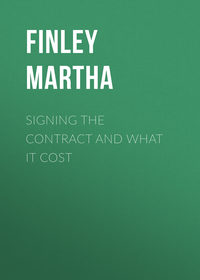 полная версия
полная версияElsie at Viamede
"The forts had one hundred and fifteen guns of various kinds and sizes, mostly smooth-bore thirty-two pounders. Above them lay the Confederate fleet of fifteen vessels, one of them an iron-clad ram, another a large, unfinished floating battery covered with railroad iron. Two hundred Confederate sharp-shooters kept constant watch along the river banks, and several fire-rafts were ready to be sent down among the Federal vessels. Both these and the sharp-shooters were below the forts. Also there were two iron chains stretched across the river, supported upon eight hulks which were anchored abreast.
"Farragut's naval expedition was the largest that had ever sailed under the United States flag, consisting of six sloops of war, twenty-one mortar schooners, sixteen gun-boats, and other vessels, carrying in all two hundred guns.
"But the vessels were built for the sea and were now to work in a much narrower space – a river with a shifting channel and obstructed by shoals.
"To get the larger vessels over the bar at the southwest pass was a work of time and great labor. They had to be made as light as possible and then dragged through a foot of mud. Two weeks of such labor was required to get the Pensacola over, and the Colorado could not be taken over at all.
"The mortar vessels were towed up stream and began to take their places. Porter disguised them with mud and the branches of trees, so that they could not be readily distinguished from the river banks, being moored under cover of the woods on the bank just below Fort Jackson. The stratagem was successful; his vessels were moored where he wished to have them, the nearest being two thousand eight hundred and fifty yards from Fort Jackson, and three thousand six hundred and eighty from Fort St. Philip.
"On the opposite side of the river, and a little farther from the forts, Porter had his six remaining vessels stationed, screening them also with willows and reeds, and mooring them under cover of the woods to conceal their true character.
"On the 18th of April, before nine o'clock in the morning, the attack was begun by a shot from Fort Jackson, then, as soon as Porter was ready, the Owasco opened fire, and the fourteen mortar boats concealed by the woods, also the six in full sight of the forts, began their bombardment.
"The gun-boats took part in the conflict by running up and firing heavy shells when the mortars needed relief. Porter was on the Harriet Lane, in a position to see what was the effect of the shells, and direct their aim accordingly.
"The fight went on for several days, then Farragut, deeming there was small prospect of reducing the forts, prepared to carry out another part of his instructions by running past them. He called a council of the captains in the cabin of the Hartford, and it was then and there decided that the attempt should be made.
"It was an intensely dark night, the wind blowing fiercely from the north, but Commander Bell with the Winona, the Itasca, Kennebec, Iroquois, and the Pinola ran up to the boom. The Pinola ran to the hulk under the guns of Fort Jackson, and an effort was made to destroy it with a petard, but failed. The Itasca was lashed to the next hulk, but a rocket sent up from the fort showed her to the foe, who immediately opened a heavy fire upon her. But half an hour of active work with chisels, saws, and sledges parted the boom of chains and logs, and the hulk to which she was attached swung round and grounded her in the mud in shallow water. But the Pinola rescued her.
"Two hours later an immense fire-raft came roaring down the stream, but, like those sent before, it was caught by our men and rendered harmless. They would catch such things with grappling-irons, tow them to the shore, and leave them there to burn out harmlessly.
"Day after day the bombardment went on, fire-rafts coming down the river every night, but Fort Jackson still held out, though its citadel had been set on fire by the shells from the mortar boats, and all the commissary stores and the clothing of the men destroyed; also the levee had been broken in scores of places by the exploding shells, so that the waters of the river flooded the parade ground and casemates.
"By sunset on the 23d, Farragut was ready for his forward movement, but Porter, with his mortar boats, was to stay and cover the advance with his fire. Farragut, on board his flag-ship, the Hartford, was to lead the way with it, the Brooklyn, and the Richmond.
"These vessels formed the first division, and were to keep near the right bank of the river, fighting Fort Jackson, while Captain Theodorus Bailey was to keep close to the western bank with his (the second) division, to fight Fort St. Philip. His vessels were the Mississippi, Pensacola, Varuna, Oneida, Katahdin, Kineo, Wissahickon, Portsmouth.
"Captain Bell still commanded the same vessels which I just mentioned as his, and his appointed duty was to attack the Confederate fleet above the forts, to keep the channel of the river, and push right on, paying no attention to the forts themselves.
"In obedience to these orders, the Itasca ran up to the boom, and at eleven o'clock showed a night signal that the channel was clear of obstruction excepting the hulks, which, with care, might be passed safely.
"A heavy fog, and the settling of the smoke from the steamers upon the waters, made the night a very dark one. No sound came from the forts, yet active preparations were going on in them for the approaching struggle, and their fleet was stationed near them in readiness to assist in the effort to prevent the Union vessels from ascending the river.
"At one o'clock every one on the Union ships was called to action, but the fleet remained stationary until two, and at half past three Farragut's and Bailey's divisions were moving up the river, each on its appointed side, and at the rate of four miles an hour.
"Then Porter's mortars, still at their moorings below the forts, opened upon those forts a terrible storm, sending as many as, if not more than, half a dozen shells, with their fiery trails, screaming through the air at the same moment.
"But no sound came from the forts until they discovered Captain Bailey's ship, the Cayuga, just as she had passed the boom, when they brought their heavy guns to bear upon her, and broke the long silence with their roar.
"When she was close under Fort St. Philip she replied with heavy broadsides of grape and canister as she passed on up the river.
"The other vessels of Bailey's division followed closely after, each imitating the Cayuga's example in delivering a broadside as she passed the forts, which they did almost unharmed, with the exception of the Portsmouth, a sailing vessel, which lost her tow, on firing her broadside, and drifted down the river.
"Captain Bell and his division were not quite so fortunate. Three of his vessels passed the forts, but the Itasca received a storm of shot, one of which pierced her boiler, and she drifted helplessly down the river. The Kennebec lost her way among the obstructions and went back to her moorings below; the Winona, too, recoiled from the storm.
"In the meantime, Farragut was in the fore rigging of the Hartford, watching with intense interest, through his night glass, the movements of the vessels under the command of Bailey and Bell, while the vessels he commanded in person were slowly nearing Fort Jackson. He was within a mile and a quarter of it when its heavy guns opened upon him. They were well aimed, and the Hartford was struck several times.
"Farragut replied with two guns which he had placed upon his forecastle, while at the same time he pushed on directly for the fort. When within a half mile of it he sheered off and gave them heavy broadsides of grape and canister; so heavy that they were driven from all their barbette guns. But the casemate guns were kept in full play, and the fight became a very severe one.
"The Richmond soon joined in it; the Brooklyn got entangled with some of the hulks that bore up the chain, and so lagged behind. She had just succeeded in freeing herself from them, when the Confederate ram Manassas came furiously down upon her, and when within about ten feet, fired a heavy bolt at her from its trap-door, aiming for her smoke stack; but fortunately the shot lodged in some sand-bags that protected her steam-drum.
"The next moment the ram butted into the Brooklyn's starboard gangway; but she was so effectually protected by chain armor that the Manassas glanced off and disappeared in the darkness.
"All this time a raking fire from the fort had been pouring upon the Brooklyn, and just as she escaped from the Manassas a large Confederate steamer attacked her. She pushed slowly on in the darkness, after giving the steamer a broadside that set it on fire and speedily destroyed it, and suddenly found herself abreast of Fort St. Philip.
"She was very close to it, and speedily brought all her guns to bear upon it in a tremendous broadside.
"In his report Captain Craven said, 'I had the satisfaction of completely silencing that work before I left it, my men in the tops witnessing, in the flashes of the shrapnel, the enemy running like sheep for more comfortable quarters.'
"While the Brooklyn was going through all this, Farragut was having what he called 'a rough time of it.' While he was battling with the forts, a huge fire-raft, pushed by the Manassas, came suddenly upon him all ablaze, and in trying to avoid it the Hartford got aground, and the incendiary came crashing alongside of her.
"In telling of it Farragut said, 'In a moment the ship was one blaze all along the port side, half way up the main and mizzen tops. But thanks to the good organization of the fire department, by Lieutenant Thornton, the flames were extinguished, and at the same time we backed off and got clear of the raft. All this time we were pouring shells into the forts and they into us; now and then a rebel steamer would get under our fire and receive our salutation of a broadside.' The fleet had not fairly passed the forts when the Confederate ram and gun-boats hastened to take part in the battle.
"The scene was now both grand and awful. Just think of two hundred and sixty great guns and twenty mortars constantly firing, and shells exploding in and around the forts; it 'shook land and water like an earthquake,' Lossing tells us, 'and the surface of the river was strewn with dead and helpless fishes.' Major Bell, of Butler's staff, wrote of it, 'Combine all that you have ever heard of thunder, and add to it all you have ever seen of lightning, and you have, perhaps, a conception of the scene. And,' continues our historian, 'all this destructive energy, the blazing fire-rafts and floating volcanoes sending forth fire and smoke and bolts of death, the thundering forts, and the ponderous rams, were crowded, in the greatest darkness just before dawn, within the space of a narrow river, "too narrow," said Farragut, "for more than two or three vessels to act to advantage. My greatest fear was that we should fire into each other; and Captain Wainwright and myself were hallooing ourselves hoarse at the men not to fire into our ships."'
"The Cayuga met the flotilla of Confederate rams and gun-boats as soon as she passed Fort St. Phillip. For a few minutes there were eighteen Confederate vessels intent upon her destruction."
"Was the Manassas one of the eighteen, sir?" queried Walter.
"Yes," replied the captain, "and the floating battery Louisiana was another. Captain Mitchell was the name of her commander, and he was also commandant of the remaining sixteen vessels of that rebel fleet.
"Captain Bailey could not fight so many at once without some assistance, so used his skill in avoiding the butting of the rams and the efforts to board his vessel. At the same time he was making such good use of his guns that, while saving his own vessels, he compelled three of the Confederate gun-boats to surrender to him before Captain Boggs and Captain Lee, of the Varuna and the Oneida came to his assistance.
"The Cayuga had then been struck forty-two times and a good deal damaged in spars and rigging, but, in accordance with Farragut's orders, she moved up the river as leader of the fleet.
"It was upon the Varuna that the enemy next poured out the vials of his wrath. In his report of the fight Captain Boggs, her commander, said that immediately after passing the forts he found himself 'amid a nest of rebel steamers.' He rushed into their midst, giving each a broadside as he passed. The first of those steamers seemed to be crowded with troops. One of the Varuna's shots exploded her boiler and she drifted ashore. Next a gun-boat and three other vessels were driven ashore in flames, and presently they blew up, one after another.
"Then the Varuna was furiously attacked by the Governor Moore, commanded by Beverly Kennon, one who had left the United States service for that of the rebels. His vessel raked along the Varuna's port, killing four men and wounding nine. Captain Boggs sent a three-inch shell into her, abaft her armor, and several shots from the after rifled gun, which partially disabled her, and she dropped out of action.
"In the meantime, another ram struck the Varuna under water with its iron prow, giving her a heavy blow in the port gangway. The Varuna answered with a shot, but it glanced harmlessly from the armored prow of the rebel ram, and it, backing off a shorting distance, shot forward again, gave the Varuna another blow in the same place, and crushed in her side.
"But the ram had become entangled, and was drawn around to the side of the Varuna, and Captain Boggs gave her five eighteen shells abaft her armor from his port guns. In telling of it afterward he said, 'This settled her and drove her ashore in flames.'
"But his own vessel was sinking; so he ran her into the bank, let go her anchor, and tied her bow up to the trees, but all the time kept his guns at work crippling the Moore.
"He did not cease firing till the water was over the gun-tracks, but then turned his attention to getting his wounded and the crew out of the vessel.
"Just then, Captain Lee, commander of the Oneida, came to his assistance. But Boggs waved him after the Moore, which was then in flames and presently surrendered to the Oneida. Kennon, her commander, had done a cowardly deed in setting her on fire and fleeing, leaving his wounded to the horrible fate of perishing in the flames. The surrender was, therefore, made by her second officer.
"That ended the fight on the Mississippi River; it had been a desperate one, but lasted only an hour and a half, though nearly the whole of the rebel fleet was destroyed. The National loss was thirty killed and not more than one hundred and twenty-five wounded."
CHAPTER IV
Captain Raymond paused, seemingly lost in thought. All waited in silence for a moment, then Violet, laying a hand on his arm, for she was seated close at his side, said with a loving smile into his eyes:
"My dear, I fear we have been tiring you."
"Oh no, not at all!" he replied, coming out of his revery and taking possession of the pretty hand with a quiet air of ownership.
"I am sure nobody else is," said Walter; "so please go on, sir, won't you? and tell us all about the taking of the forts and the city."
"I will," replied the captain. "By the way, I want to tell you about a powder boy on board of the Varuna, Oscar Peck, a lad of only thirteen years, who showed coolness and bravery which would have entitled a man to praise.
"Captain Boggs was very much pleased with him, and in his report to Farragut praised him warmly. He said that seeing the lad pass quickly he asked where he was going in such a hurry. 'To get a passing box, sir,' replied the lad; 'the other was smashed by a ball.' When the Varuna went down Oscar disappeared. He had been standing by one of the guns and was thrown into the water by the movement of the vessel. But in a few minutes he was seen swimming toward the wreck. Captain Boggs was standing on a part of the ship that was still above water, when the lad climbed up by his side, gave the usual salute, and said, 'All right, sir, I report myself on board.'"
"Ah," cried Walter exultantly, "he was a plucky American boy! I'm proud of him."
"Yes," said the captain, "and the more men and boys we have of a similar spirit the better for our dear land.
"But to go on with my story. Captain Bailey moved on up the river with his crippled vessel, the Cayuga, leaving the Varuna to continue the fight at the forts.
"A short distance above Fort St. Philip was the Quarantine Station. Opposite to it was a Confederate battery in charge of several companies of sharp-shooters, commanded by Colonel Szymanski, a Pole.
"On perceiving the approach of the Cayuga, they tried to flee, but a volley of canister-shot from her guns called a halt, and they were taken prisoners of war.
"By that time the battle at the forts was over and the remaining twelve ships presently joined the Cayuga. Then the dead were carried ashore and buried."
"And where was Butler all this time, sir?" queried Walter.
"He had been busy preparing for his part of the work while the naval officers were doing theirs," was the reply. "His men were in the transports at the passes and could hear distinctly the booming of the guns and mortars, but the general was at that time on the Saxon, which was following close in the rear of Bailey's division, until the plunging of shot and shell into the water around her warned Butler that he had gone far enough. He then ordered the Saxon to drop a little astern, an order which was by no means disagreeable to her captain and was promptly obeyed, for he had on board eight hundred barrels of gunpowder; a dangerous cargo, indeed, when exposed to the fiery missiles of the enemy."
"Wasn't it?" exclaimed Rosie.
"Where was Porter just then, sir?" asked Walter.
"He and his mortar fleet were still below the forts," replied the captain, "and just as Butler had ordered his vessel away from that dangerous spot, the rebel monitor Manassas came moving down into the midst of his fleet. She had just been terribly pounded by the Mississippi and was a helpless wreck, but that was not perceived at first, and some of the mortars opened fire upon her, but stopped when they saw what was her condition: her hull battered and pierced, her pipes twisted and riddled by shot, smoke pouring from every opening. In a few minutes her only gun went off, flames burst out from stern, trap-door, and bow port, and she went hissing to the bottom of the river.
"Butler now hurried to his transports and took them to Sable Island, twelve miles in the rear of Fort St. Philip. From there they went in small boats, through the narrow and shallow bayous, piloted by Lieutenant Weitzel. It was a most fatiguing journey, the men sometimes having to drag their boats through cold, muddy water waist deep. But the brave, patriotic fellows worked on with a will, and by the night of the 27th they were at the Quarantine, ready to begin the assault on Fort St. Philip the next day, when they were landed under cover of the guns of the Mississippi and the Kineo. Butler sent a small force to the other side of the river above Fort Jackson, which Porter had been pounding terribly with the shells from his mortars. On the 26th, Porter sent a flag of truce with a demand for the surrender of the fort, saying that Farragut had reached New Orleans and taken possession.
"Colonel Higginson, the commander of the fort, replied that he had no official report of that surrender, and that until he should receive such he would not surrender the fort; he could not entertain such a proposition for a moment.
"On the same day, General Duncan, commander of the coast defences, but at that time in Fort Jackson, sent out an address to the soldiers, saying, 'The safety of New Orleans and the cause of the Southern Confederacy, our homes, families, and everything dear to man yet depend upon our exertions. We are just as capable of repelling the enemy to-day as we were before the bombardment.'
"Thus he urged them to fight on. But they did not all agree with the views he expressed. They could see the blackened fragments of vessels and other property strewing the waters of the river as it flowed swiftly by, and the sight convinced them of the truth of the report which had reached them of the fall of New Orleans. They had heard, too, of the arrival of Butler's troops in the rear of Fort St. Philip.
"Doubtless they talked it all over among themselves that night, as a large number of them mutinied, spiked the guns bearing up the river, and the next day went out and surrendered themselves to Butler's pickets on that side of the river, saying they had been impressed, and would not fight the government any longer. Their loss made the surrender of the fort a necessity, and Colonel Higginson accepted the generous terms offered him by Porter. He and Duncan went on board the Harriet Lane and the terms of surrender were reduced to writing.
"While that was going on in her cabin, a dastardly deed was done by the Confederate officer Mitchell, who, as I have said, commanded the battery called the Louisiana. It lay above the forts. He had it towed out into the strong current, set on fire and abandoned, leaving the guns all shotted, expecting she would float down and explode among Porter's mortar fleet; but a good Providence caused the explosion to come before she reached the fleet. It took place when she was abreast of Fort St. Philip, and a soldier, one of its garrison, was killed by a flying fragment. Then she went to the bottom, and the rest of the Confederate steamers surrendered.
"Porter and his mortar fleet were still below the forts, but Farragut had now thirteen of his vessels safely above them and was ready to move upon New Orleans.
"Half an hour after he reached the Quarantine, he sent Captain Boggs to Butler with despatches. Boggs went in a small boat through shallow bayous in the rear of Fort St. Philip, and, as I have already said, the next day Butler and his troops arrived at the Quarantine in readiness to assault the forts.
"Fort St. Philip was as perfect when taken by the Union forces as before the fight, and Fort Jackson was injured only in its interior works.
"The entire loss of the Nationals in all this fighting was 40 killed and 177 wounded. No reliable report was given of the Confederate losses in killed and wounded. The number of prisoners amounted to nearly one thousand.
"General Lovell, who had command of the Confederate troops at New Orleans, had gone down the river in his steamer Doubloon, and arrived just as the National fleet was passing the forts. He was near being captured in the terrible fight that followed, but escaped to the shore and hurried back to New Orleans as fast as courier horses could carry him.
"A rumor of the fight and its results had already reached the city, and when he confirmed it a scene of wild excitement ensued; soldiers hurried to and fro, women were in the street bareheaded, brandishing pistols, and screaming, 'Burn the city! Never mind us! Burn the city!'
"Merchants fled from their stores, and military officers impressed vehicles to carry cotton to the levees to be burned. Four millions of dollars in specie was sent out of the city by railway; foreigners crowded to the consulates to deposit money and other valuables for safety, and Twiggs, the traitor, fled, leaving to the care of a young woman the two swords that had been awarded him for his services in Mexico.
"Lovell believed that he had not a sufficient number of troops to defend the city, and convinced the city authorities that such was the fact. Then he proceeded to disband the conscripts and to send munitions of war, stores of provisions, and other valuable property to the country by railroad and steamboats. Some of the white troops went to Camp Moore, seventy-eight miles distant, by the railroad, but the negro soldiers refused to go.









